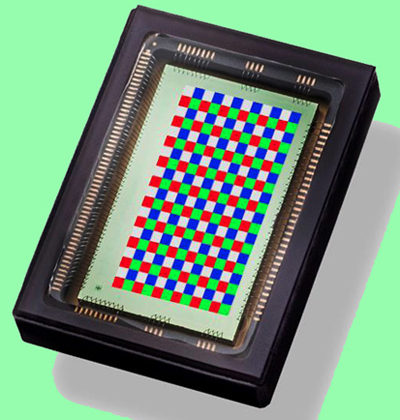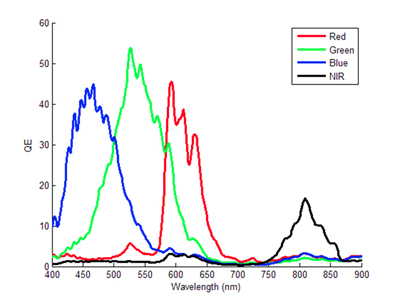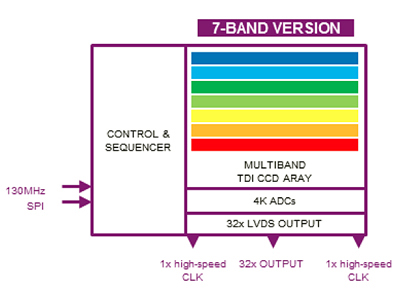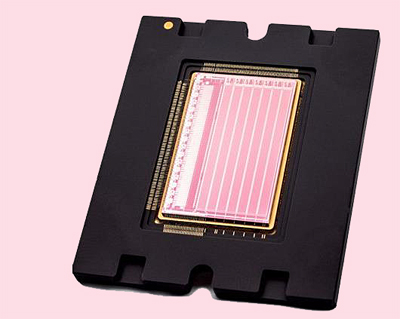08 Feb 2017
Products combine color and NIR imaging; fuse benefits of snapshot and linescan technologies.
At last week’s SPIE Photonics West in San Francisco, imec, the research and innovation hub in nano-electronics and digital technologies, introduced several a range of market-ready imaging and camera systems, including the Snapshot image sensor with integrated color (RGB) and narrow-band near-infrared (NIR) filters.

Snapshot mosaic RGB + NIR multi-spectral image sensor.
imec says this “breakthrough” in optical filter integration and sensing enables different applications, ranging from medical, industrial, security surveillance and automotive to virtual and augmented reality, where near-infrared signals need to be extracted and overlaid on top of color images.
“Our RGB-NIR multispectral platform demonstrates for the first time the possibility of integrating standard RGB color filters, the NIR-cut filter, NIR narrow band-pass filters and on-chip microlens technology, down to small pixels as small as 5µm,” the company commented. The NIR band-pass filter and design pattern implementation can be tuned to match requirements of specific applications, such as the wavelength of a particular laser or LED light.

Measured QE responses of RGB + NIR spectral channels.
Multispectral TDI sensor based on CCD in CMOS

Schematic of a multispectral TDI image sensor with 7 bands.
TDI imaging technology relies on the collection of charges that are generated from multiple exposures of an object moving linearly with respect to the imager. Traditionally, this is done through CCD technology where the charge transfer in the CCD pixels results in a noiseless integration and transfer synchronized with the moving scene.
imec produced the sensors in one CMOS-compatible flow. Using backside-illumination technology, the area that is exposed to light is maximized, increasing the sensor’s light sensitivity. To enhance the TDI imaging performance, the TDI CCD-in-CMOS technology was combined with multispectral or RGB color filters, which can be processed at wafer level.

Packaged prototype of a multispectral TDI image sensor with 7 bands.
Jonathan Borremans, program manager at imec, commented, “This low-power TDI technology excels in speed and sensitivity. The availability of multispectral filters allows the extraction of significantly more features of the moving scene than with a traditional TDI solution. This makes the technology attractive for applications, such as remote sensing, medical imaging and industrial machine vision.”
Snapscan hyperspectral imaging camera
Thirdly, imec’s Snapscan camera combines a "good" signal to noise ratio with spatial and spectral resolution advantages of linescan hyperspectral imaging technology and the ability to acquire data-sets as easily as with a snapshot camera, the developer says.
imec commented, “scanning is handled internally, using a miniaturized scanning stage. Full hyperspectral images can be acquired in a matter of seconds."
Currently, the maximal RAW spatial resolution that is possible to achieve is 3650x2048px (7Mpx) per image, with a spectral resolution of 150+ spectral bands within the 470-900nm range. Flat signal-to-noise ratios, as high as 200 over the full spectral range, have already been demonstrated thanks to software features that optimize the reconstruction and correction of hyperspectral data cubes.
Jerome Baron, business development manager for imec’s integrated imaging and vision system teams, said, “Our Snapscan camera technology will open up the market for hyperspectral imaging research and development, thanks to its simplicity to create high quality datasets, essential for application validation and building spectral libraries.
“We see many additional opportunities beyond the R&D market, especially in applications such as digital microscopy for pathology and cytogenetics, medical imaging for endoscopy, wound diagnostics and guided surgery, as well as in precision agriculture for unmanned ground vehicles and robotics”.
| © 2025 SPIE Europe |
|